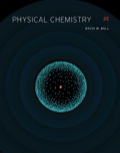
Physical Chemistry
2nd Edition
ISBN: 9781285969770
Author: Ball
Publisher: Cengage
expand_more
expand_more
format_list_bulleted
Question
Chapter 14, Problem 14.92E
Interpretation Introduction
Interpretation:
The derivation of expression used in the solution of example
Concept introduction:
The P and R branch of lines are produced because of rotational and vibrational spectrum occurring together. The P and R branch of lines are due to change in the rotational level of molecule with the vibrational change. There some selection rules for the transitions to occur according to which these lines are formed and given names as P and R branch lines.
Expert Solution & Answer
Want to see the full answer?
Check out a sample textbook solution
Students have asked these similar questions
To anyone who will answer this correctly, thank you.
Which anion was the easiest to get the correct result for? Briefly justify your answer.
Does anybody have answers to this, I really don't know how to answer this since our teacher just gave us that but didn't give us any instructions. Please help me with this.
Chapter 14 Solutions
Physical Chemistry
Ch. 14 - Prob. 14.1ECh. 14 - Determine if the following integrals can be...Ch. 14 - What is the frequency of light having the...Ch. 14 - What is the wavelength of light having the given...Ch. 14 - What is the energy of light having each...Ch. 14 - The Cu(H2O)62+ complex has octahedral symmetry. Is...Ch. 14 - What are the wavelength, speed, and energy of a...Ch. 14 - Prob. 14.8ECh. 14 - Prob. 14.9ECh. 14 - Prob. 14.10E
Ch. 14 - Prob. 14.11ECh. 14 - Prob. 14.12ECh. 14 - Prob. 14.13ECh. 14 - Prob. 14.14ECh. 14 - Diatomic sulfur, S2, was detected in the tail of...Ch. 14 - Prob. 14.16ECh. 14 - Prob. 14.17ECh. 14 - Prob. 14.18ECh. 14 - Prob. 14.19ECh. 14 - Prob. 14.20ECh. 14 - Prob. 14.21ECh. 14 - Prob. 14.22ECh. 14 - Which of the following molecules should have pure...Ch. 14 - Which of the following molecules should have pure...Ch. 14 - The following are sets of rotational quantum...Ch. 14 - The following are sets of rotational quantum...Ch. 14 - Derive equation 14.21 from the E expression...Ch. 14 - Prob. 14.28ECh. 14 - Prob. 14.29ECh. 14 - Lithium hydride, 7Li1H, is a potential fuel for...Ch. 14 - Prob. 14.31ECh. 14 - Prob. 14.32ECh. 14 - Prob. 14.33ECh. 14 - Prob. 14.34ECh. 14 - Prob. 14.35ECh. 14 - Prob. 14.36ECh. 14 - From the data in Table 14.2, predict B for DCl D...Ch. 14 - A colleague states that the pure rotational...Ch. 14 - Prob. 14.39ECh. 14 - Prob. 14.40ECh. 14 - Prob. 14.41ECh. 14 - Prob. 14.42ECh. 14 - Prob. 14.43ECh. 14 - Determine E for J=20J=21 for HBr assuming it acts...Ch. 14 - Determine the number of total degrees of freedom...Ch. 14 - Determine the number of total degrees of freedom...Ch. 14 - Prob. 14.47ECh. 14 - Prob. 14.48ECh. 14 - Prob. 14.49ECh. 14 - Prob. 14.50ECh. 14 - Prob. 14.51ECh. 14 - Prob. 14.52ECh. 14 - Prob. 14.53ECh. 14 - Prob. 14.54ECh. 14 - Prob. 14.55ECh. 14 - Prob. 14.56ECh. 14 - Prob. 14.57ECh. 14 - Prob. 14.58ECh. 14 - Prob. 14.59ECh. 14 - Prob. 14.60ECh. 14 - Prob. 14.61ECh. 14 - Prob. 14.62ECh. 14 - Prob. 14.63ECh. 14 - Prob. 14.64ECh. 14 - Prob. 14.65ECh. 14 - Prob. 14.66ECh. 14 - Prob. 14.68ECh. 14 - Prob. 14.69ECh. 14 - Prob. 14.70ECh. 14 - Prob. 14.71ECh. 14 - Prob. 14.72ECh. 14 - Prob. 14.73ECh. 14 - Prob. 14.74ECh. 14 - Prob. 14.75ECh. 14 - Prob. 14.76ECh. 14 - Prob. 14.77ECh. 14 - Prob. 14.78ECh. 14 - Prob. 14.79ECh. 14 - Prob. 14.80ECh. 14 - Prob. 14.81ECh. 14 - Prob. 14.82ECh. 14 - Prob. 14.83ECh. 14 - Prob. 14.84ECh. 14 - Prob. 14.85ECh. 14 - Dioctyl sulfide, (C8H17)2S, and hexadecane,...Ch. 14 - Where would you expect vibrations for ethyl...Ch. 14 - Prob. 14.88ECh. 14 - Prob. 14.89ECh. 14 - Prob. 14.90ECh. 14 - Prob. 14.91ECh. 14 - Prob. 14.92ECh. 14 - Prob. 14.93ECh. 14 - Prob. 14.94ECh. 14 - The mutual exclusion rule states that for certain...Ch. 14 - Prob. 14.96ECh. 14 - Prob. 14.97ECh. 14 - Prob. 14.98ECh. 14 - Prob. 14.99ECh. 14 - Construct and compare the energy level diagrams...Ch. 14 - Prob. 14.101E
Knowledge Booster
Similar questions
arrow_back_ios
arrow_forward_ios
Recommended textbooks for you
 Physical ChemistryChemistryISBN:9781133958437Author:Ball, David W. (david Warren), BAER, TomasPublisher:Wadsworth Cengage Learning,
Physical ChemistryChemistryISBN:9781133958437Author:Ball, David W. (david Warren), BAER, TomasPublisher:Wadsworth Cengage Learning,

Physical Chemistry
Chemistry
ISBN:9781133958437
Author:Ball, David W. (david Warren), BAER, Tomas
Publisher:Wadsworth Cengage Learning,